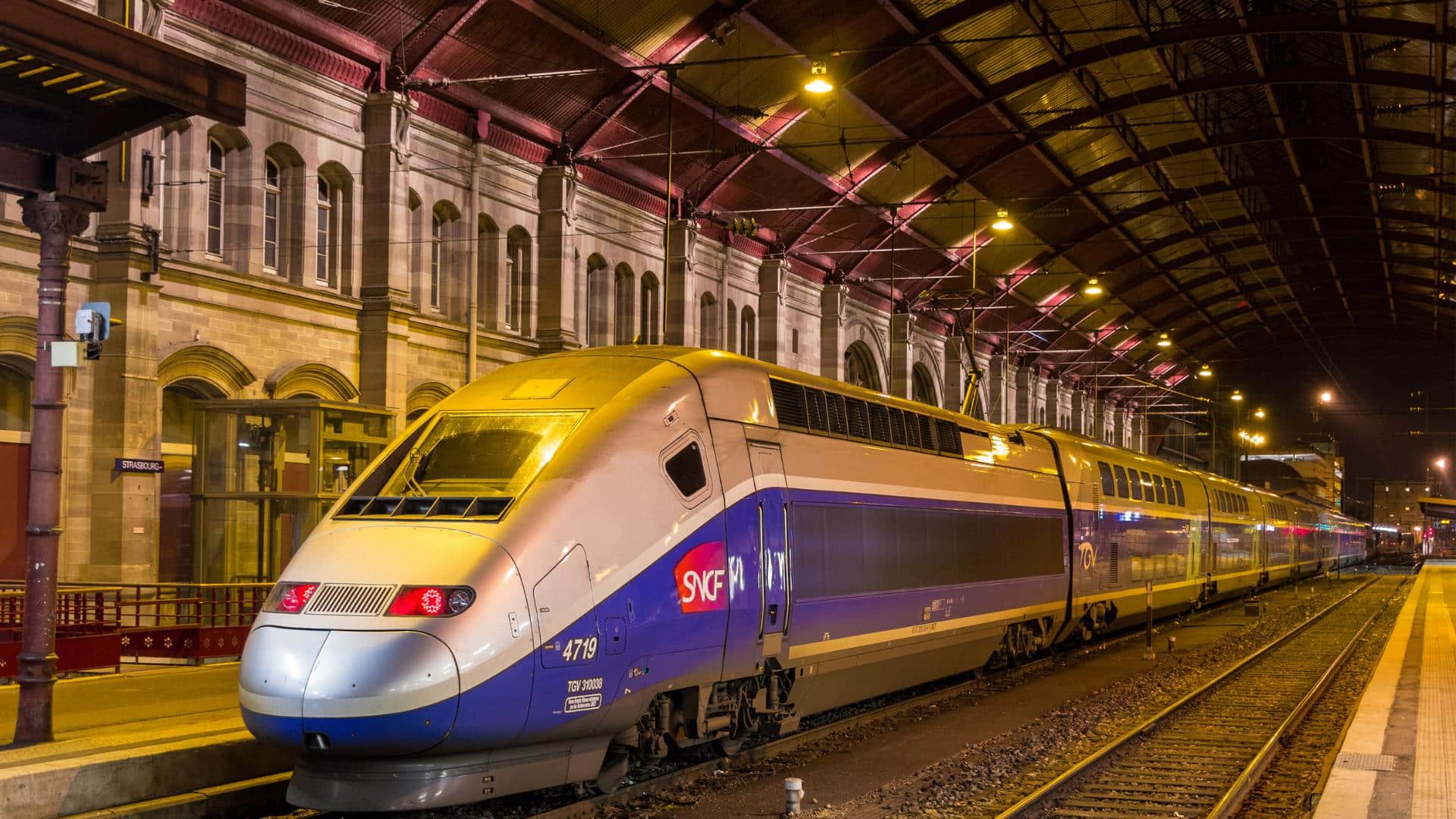In the United States, people are obsessed with cars and highways. In France, a train or bus will get you where you want to go.

A high speed train in France. (Credit: Leonid Andronov)
This article, by high school student Amelia Weiss, was produced out of News Decoder’s school partnership program. Amelia is a student at School Year Abroad, a News Decoder partner institution. Learn more about how News Decoder can work with your school.
The metro doors slid shut with a quiet hum, followed by the routine chime of the station’s announcement. I had barely made it inside the B line metro before the doors slammed shut, narrowly missing the strands of my big curly hair.
The metro was packed, as the air buzzed with what felt like the voices of hundreds of French people. The seats were all taken, which meant I had to stand, but that didn’t bother me. It was only two stops from my house to the school. I tightened my grip on the metro pole, bracing myself for the inevitable jolt as the metro launched forward.
The scent of cigars lingered through the air, weaving through the smells of cologne and perfume. Though surrounded by strangers, I wasn’t afraid. In fact I was oddly relieved, finding comfort in the simplicity public transportation brought to my daily commute. In France, public transportation is a way of life, seamlessly woven into the daily routines of its citizens.
Across the Atlantic, however, the system is quite different — students in the United States climb into their cars, the hum of their engines and the morning radio the only sound accompanying them.
Two worlds, two vastly different approaches to transportation. Yet both share the same goal: getting from one place to another. So why does France heavily encourage public transportation while the United States remains reliant on cars?
Mass transport means independence.
For students coming from the United States the difference is evident.
“There are no metros back home,” said Elliana Faykus, from Houston, Texas. “We have occasional buses, but nobody really takes public transportation. Coming here, I can use public transportation, and the independence that comes with it is amazing.”
Aside from the noticeable disparity between U.S. and French public transportation, this difference is deeply rooted in urban planning, government policies and historical development. France has long prioritized public transportation as a public good, investing heavily in infrastructure to ensure accessibility and efficiency.
Cities are designed around transit hubs rather than sprawling highways, making it easy for people to rely on buses, trains and metros. Additionally, environmental concerns and efforts to reduce traffic congestion have led to policies that favor public transit over private car ownership.
France’s “Versement Transport” tax on businesses, for example, directly funds public transit, and major cities like Paris have enacted car bans in certain zones to reduce emissions and congestion.
In contrast, the United States has systematically prioritized automobiles. The post-World War II suburban boom, fueled by government incentives such as the Federal Aid Highway Act of 1956, led to car-centric urban planning. The automobile and oil industries heavily influenced infrastructure development, pushing for policies that favored highway expansion over public transit.
As a result, cities were designed with sprawling suburbs and minimal investment in public transit, making car ownership a necessity rather than an option. Additionally, the Highway Trust Fund, which funds road construction through fuel taxes, allocates a much larger percentage of funds to highways than to transit projects, further entrenching car dependency.
Travel made easy
This divergence becomes evident when students from the United States who study in France experience a transit system that prioritizes accessibility.
Tree Payne, who came to France from California, said that while there are some trains back home, they aren’t widely used. “Most of the time, my parents drive me everywhere,” he said. “Being here, having the ability to just swipe a card and travel across the city is like a breath of fresh air.”
Amanda Dominique is from Boston which is known in the United States as a public transport-friendly city. “The MBTA, which we call the ‘T,’ is the oldest metro system in the U.S., and it hasn’t been renovated in decades,” she said. “It’s dirty, unreliable and every winter it freezes over. The lines are often overcrowded or occupied by homeless individuals, which makes people feel unsafe. So, we all end up relying on cars instead.”
Despite coming from different parts of the United States, all three students share a common experience: public transportation in the United States is not well-maintained, widely available or culturally encouraged in the way it is in France.
The preference in the United States for cars is not solely a policy choice. It is also a matter of practicality. Jordan Young, a deputy public affairs officer in the Wyoming State Department of Transportation, said that much of the public transportation is localized within individual towns. “It doesn’t necessarily connect people from town to town,” she said. “So, it just doesn’t make sense for most people to rely on public transportation.”
Outside U.S. cities, people drive.
The rural nature of the U.S. state of Wyoming makes car dependency inevitable.
“People have to drive long distances just to get groceries, especially if they live on a ranch or outside of town,” Young said. “Public transportation is mostly limited to town centers, and even then, it primarily serves underserved populations like seniors who can’t drive.”
However, even in major urban areas, public transportation often suffers due to a lack of investment, urban sprawl and safety concerns. Unlike France, where the government heavily subsidizes transit and ensures its reliability, many transit systems in the United States suffer from budget cuts, outdated infrastructure and limited coverage.
Many French citizens say they prefer public transportation over cars because of its accessibility.
Public transportation in France is designed to be convenient, efficient and reliable. Government subsidies make it affordable for the average citizen, and transit-oriented urban planning ensures that metros, trams and buses connect people seamlessly to their destinations. As a result, public transportation is not just an option — it’s the default.
A government that prioritizes mass transit
France has also implemented policies to encourage transit use and reduce car dependency. For example:
• Low-emission zones: In French, low-emission zones are called zones à faibles émissions (ZFE). These zones range from the center of a city to a larger urban area, where only certain vehicles with certain colors of the emission sticker are allowed to enter.
• Fare-free public transportation trials: Certain cities encourage ridership and accessibility.
• Extensive high-speed rail (TVG) networks make intercity travel practical without a car.
The clear differences between France and the United States highlight a fundamental distinction in urban planning, policy priorities and cultural attitudes toward transportation. While France continues to invest in making transit more accessible and environmentally friendly, the United States remains entrenched in car-centric infrastructure.
There are signs that attitudes in the United States may be shifting. Cities like New York, San Francisco and Washington, D.C. are expanding bike lanes, introducing congestion pricing and improving transit systems.
Some states have begun implementing car-free zones and bus rapid transit (BRT) systems modeled after European successes. The question remains: Will the United States take inspiration from countries like France and embrace public transit as a priority? Or will the reliance on cars remain the dominant mode of transportation?
For now, students from the United States who study in France continue to marvel at the ease of getting around — no car required.
Questions to consider:
1. Why do French citizens seem to have more access to public transport than people in the United States?
2. Why, in city like Boston which has a train system, do people choose to drive cars?
3. Do you prefer to take a car or a public train or bus when you need to get somewhere? Why?

Amelia Weiss is in her second year at the Head-Royce School in California. This semester, she is studying abroad in Rennes, France, immersing herself in a new culture and expanding her horizons. She has a deep passion for writing, using it as a way to express herself and find solace in the quiet it brings. Beyond her writing, she is a dedicated dancer, an Eagle scout candidate, a co-captain of her public forum speech and debate team and an avid baker who loves experimenting in the kitchen. In her free time, she writes purely for the joy of it, letting her imagination take shape in stories and reflections.

Idiotic. While we support the world with our tax money and they build up their infrastructure we suffer with depleted,degraded and deplorable mass transit. Maybe fairer tariffs and less foreign aid we can build efficient high speed trains!